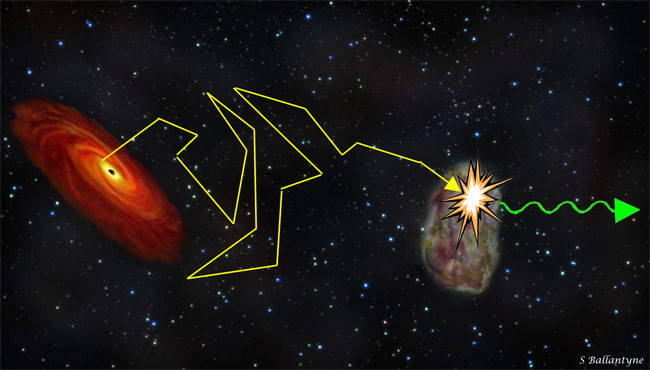The Milky Way's Pinball Wizard

In a cosmicgame of pinball, black holesfling high-energy protons into space, where they zigzag around at nearlight-speeds before smashing into low-energy protons, finds a new study.
Then thecollisions send bursts of gammarays flying out from the center of our galaxy, which explains for the firsttime the mechanism for the high-energy jets first spotted in 2004.
This proton-slingingcould explain more than this cataclysmic light show deep in our galaxy. The scientists suggest otherblack holes in the universe couldrely on the pinball mechanism to produce enormous jets of light.
"Ourgalaxy's central supermassive object has been a constant source of surpriseever since its discovery some 30 years ago," said study team member FulvioMelia, an astrophysicist at the University of Arizona (UA).
"Slowlybut surely it has become the best-studied and most compelling black hole in theuniverse," Melia said. "Now we're even finding that its apparent quietness overmuch of the spectrum belies the real power it generates a mere breath above itsevent horizon--the point of no return."
Rockin'rays
In recentyears, astronomers have tried to get at the secrets of this gamma-raylight show, which originates from our galactic middle in the neighborhoodof a supermassiveblack hole called SagittariusA* and boasting 3 million solarmasses.
Get the Space.com Newsletter
Breaking space news, the latest updates on rocket launches, skywatching events and more!
Like all black holes, SagittariusA* is veiled in a whirlpool of churning spacetime, the outer border ofwhich is called the eventhorizon. Nothing, not even light, can escape the black hole's immensegravitation once it passes this perimeter, so astronomers have had a difficulttime figuring out what exactly goes on around a black hole.
And alsolike many black holes, SagittariusA* emits X-rays as it devours matter crossing the eventhorizon.
Based on yearsof theoretical sleuthing, Melia and his colleagues have suggested that chaoticmagnetic fields near this event horizon accelerate protons and other particlesto high energies.
Playpinball
To put thetheory to an Earthly test, Melia and David Ballantyne, also of UA, created acomputer model that tracked the trajectories of more than 200,000 protonsfloating freely in a superheated gas called plasma.
The modelfound that gravity from SagittariusA* hurls protons from the magnetizedplasma to near light-speeds with energies as high as 100 trillion electron volts.As if shot from a pinball machine's flippers--the black hole in this case--theparticles zigzag along random paths [image]so that it takes thousands of years for each to make it beyond 10 light-yearsof the black hole.
Once ininterstellar space, the protons smash into low-energy protons to form pions.These particles of matter immediately decay into high-energy gammarays that shoot in all directions.
"So a veryhigh-energy proton can dump its energy into radiation through that mechanism," Ballantynetold SPACE.com.
Thediscovery could explain how the most powerful blackholes in the universe produce their jets extending over intergalacticproportions, the scientists suggest.
"The sameparticle slinging almost certainly occurs in all black-hole systems, thoughwith much greater power earlier in the universe," Melia said.
Thefindings are detailed in the current issue of Astrophysical Journal Letters.
- Top 10 Star Mysteries
- Black Holes: Dark and Deadly
- Vote: The Strangest Things in Space
- The New Tourist's Guide to the Milky Way
Join our Space Forums to keep talking space on the latest missions, night sky and more! And if you have a news tip, correction or comment, let us know at: community@space.com.










